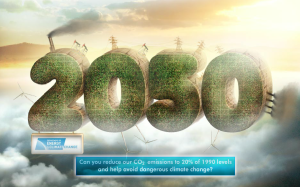Since its launch in 2011, My2050 has enjoyed much success; including being used by the DECC youth panel and a series of events such as the climate change pathways conference. The tool is also (perhaps most excitingly) included in a My2050 schools toolkit available for engaging students between the ages of 11 and 16 in debates about climate change and energy.
For anyone who is yet to have a go, My2050 challenges you to get UK CO₂ emissions below 20% by 2050 by setting how much effort is applied to areas both in the Supply and Demand sectors – and it’s not a simple feat.
Most recently the tool has been both put to the test by four Guardian journalists as part of its #bigenergydebate series, as well as being included in an academic paper published online by Cardiff University titled ‘Creating a national citizen engagement process for energy policy’.
The Guardian asks four journalists what they would do differently
It’s interesting to see how individuals approach the My2050 challenge and to hear the rationale behind their decisions. The common theme to emerge from the Guardian article is how difficult it is to balance supply and demand – working out where, and how deep, the cuts should be.
“The exercise was valuable in forcing confrontation with demand as well as supply. The latter is easier to navigate.”
David Walker, contributing editor for the Guardian
Tracking the journalists’ thoughts and opinions as they were actually using the tool also helped to expose the difficult decisions which are needed.
“Oooh, it’s fiddly, this balancing demand with supply while getting down to 20% of current carbon emissions.”
Louise Tickle, social affairs journalist from the Guardian
Cardiff University explore the challenges of creating a national citizen engagement process for energy policy
In a more academic context, the My2050 tool proved useful in presenting the higher level complexities of system change to a varied audience, as well as improving engagement in policy change.
“After submitting their my2050 futures in the survey phase. participants indicated that they were enthusiastic, interested, and showed evidence of having carefully evaluated what they wanted to achieve”
Quote referenced from ‘Creating a national citizen engagement process for energy policy’
What all of these examples show, is the huge diversity of uses for such a tool – not to mention the broad range of individuals who can be engaged as part of what is a very complex challenge to address.
In the three years since its launch, the landscape (environmentally, politically, economically) has, of course, changed. Were My2050 built today, might the emergence of fracking, the decreasing price of oil and the renewed focus on nuclear power change the structure and approach?
These developments provide a good example of what the My2050 tool plays a part in – highlighting the continuous flux that underpins the complexity of balancing environment, economy and energy demand. That My2050 still continues to encourage discussion and Deliberation on the difficult questions around UK energy provision is something we are pleased about; perhaps the important thing is just that the conversation continues.

